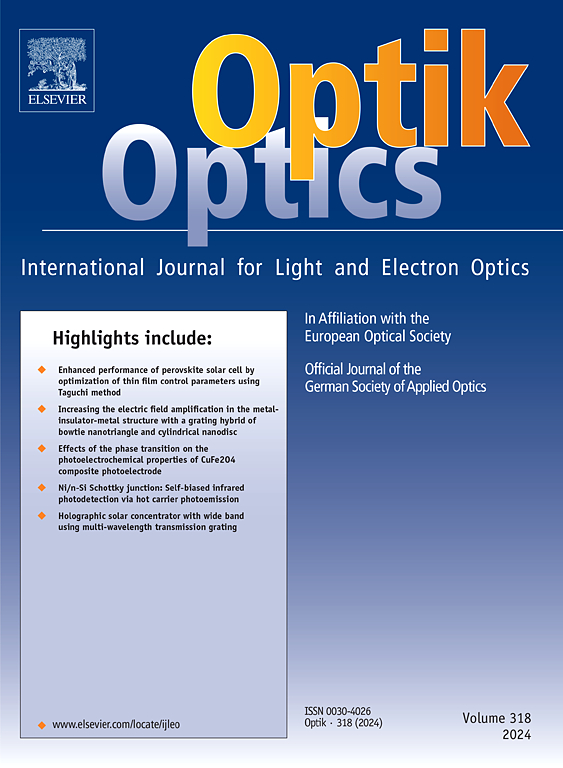Multiplexing and demultiplexing in hexagonal plasmonic lens induced on Weyl semimetals
IF 3.1
3区 物理与天体物理
Q2 Engineering
引用次数: 0
Abstract
In this study, a hexagonal plasmonic lens engraved on Weyl semimetals has been designed. The modulation of plasmonic vortices caused by plasmonic lens as a function of wavelength modulation have been demonstrated using FDTD simulations. Further, a concentric hexagonal lens having 3 rings satisfying Bragg condition has been proposed. Due to the constructive interference caused by the lens' design, the maximum intensity is greater than the single ring plasmonic lens. The number of vortices also increases according to a non-linear quadratic formula when lens radius is changed, imbibing Moore's law followed in semiconductor industry. The mathematical calculation followed by the MATLAB visualizations of the theoretically computed electrical field intensity and phase distribution corroborates quite well with the FDTD simulation results. Finally, a device scheme based on spatial light modulator is presented for information encoding by multiplexing and demultiplexing the plasmonic vortices. We also derived the electric field equations of different optical vortices of arbitrary topological order (tm), conceive different weight coefficients (am) and positions (ρn, θn) in the far field emerging from hexagonal plasmonic lens. This method could significantly impact optical communication, potentially marking one of the very first deep exploration of this topic using plasmonic lenses.
Weyl半金属诱导六角形等离子体透镜的多路复用与解路复用
在本研究中,设计了一种六角形等离子体透镜,该透镜是在Weyl半金属上雕刻的。利用时域有限差分模拟证明了等离子体透镜引起的等离子体涡旋的调制是波长调制的函数。在此基础上,提出了满足布拉格条件的三环同心圆六角形透镜。由于透镜设计引起的相消干涉,最大强度大于单环等离子体透镜。当透镜半径改变时,旋涡数也按照非线性二次公式增加,吸收了半导体工业中遵循的摩尔定律。数学计算和MATLAB可视化显示理论计算的电场强度和相位分布与FDTD仿真结果吻合较好。最后,提出了一种基于空间光调制器的等离子体涡旋复用和解复用的信息编码器件方案。我们还推导了任意拓扑阶数(tm)的不同光涡旋的电场方程,得到了六角形等离子体透镜产生的远场中不同的权系数(am)和位置(ρn, θn)。这种方法可能会对光通信产生重大影响,可能标志着使用等离子体透镜对这一主题的首次深入探索之一。
本文章由计算机程序翻译,如有差异,请以英文原文为准。
求助全文
约1分钟内获得全文
求助全文
来源期刊

Optik
物理-光学
CiteScore
6.90
自引率
12.90%
发文量
1471
审稿时长
46 days
期刊介绍:
Optik publishes articles on all subjects related to light and electron optics and offers a survey on the state of research and technical development within the following fields:
Optics:
-Optics design, geometrical and beam optics, wave optics-
Optical and micro-optical components, diffractive optics, devices and systems-
Photoelectric and optoelectronic devices-
Optical properties of materials, nonlinear optics, wave propagation and transmission in homogeneous and inhomogeneous materials-
Information optics, image formation and processing, holographic techniques, microscopes and spectrometer techniques, and image analysis-
Optical testing and measuring techniques-
Optical communication and computing-
Physiological optics-
As well as other related topics.
 求助内容:
求助内容: 应助结果提醒方式:
应助结果提醒方式:


